Publication Details
- First Published:Bulletin, 6 May 1893.
- Source:While The Billy Boils, Sydney, Angus and Robertson, 1896
| "On the Edge of a Plain" | |
|---|---|
| Short story by Henry Lawson | |
| Country | Australia |
| Language | English |
| Publication | |
| Published in | The Bulletin |
| Media type | print (periodical) |
| Publication date | 6 May 1893 |
| Series | Jack Mitchell stories |
"On The Edge of a Plain" is a sketch story by Australian writer Henry Lawson, featuring his recurring character Jack Mitchell. The story was originally published in The Bulletin on 6 May 1893, and was collected in While the Billy Boils in 1896. [1] It is considered among Lawson's best Mitchell stories. [1]
Mitchell and his mate drop their swags, and sit down in the mulga shade on the edge of a plain. Mitchell reflects about the last time he saw his family, after having been away for eight years. While he speaks, he holds a young cattle-pup, and occasionally intercuts his tale with observations about the pup's feet, or a request for a knife. With his story complete, Mitchell and his mate take up their swags, "[turn] their unshaven faces to the wide, hazy distance, and [leave] the timber behind them."
"On The Edge of a Plain" is an example of a sketch story, a style of short story of which Lawson was particularly fond. [1] The story itself contains very little plot, and simply describes one particular moment in Mitchell's life.
"On The Edge of the Plain" has been cited as the "perfect" example of an effective sketch story. [1] Critic John Barnes believes that the story was ahead of its time, writing that "to a modern reader of Chekhov, the art of this little story is quickly recognised, but the originality of what Lawson was doing on his own went unremarked when While the Billy Boils was published in 1896." [1]
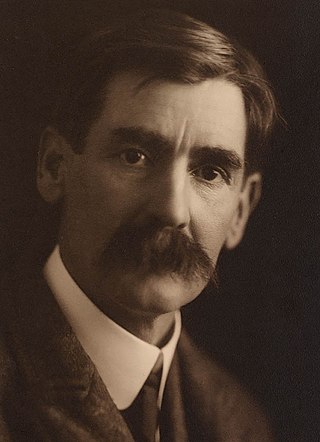
Henry Archibald Hertzberg Lawson was an Australian writer and bush poet. Along with his contemporary Banjo Paterson, Lawson is among the best-known Australian poets and fiction writers of the colonial period and is often called Australia's "greatest short story writer".
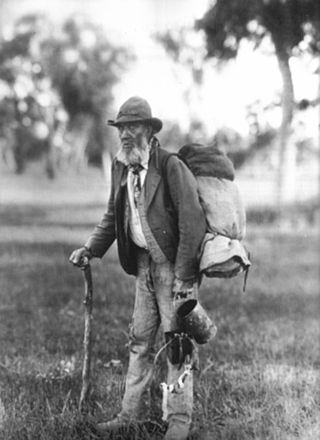
A swagman was a transient labourer who travelled by foot from farm to farm carrying his belongings in a swag. The term originated in Australia in the 19th century and was later used in New Zealand.
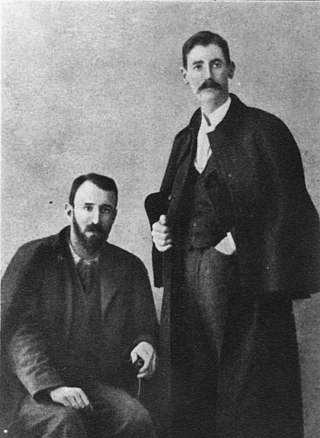
John Le Gay Brereton was an Australian poet, critic and professor of English at the University of Sydney. He was the first president of the Fellowship of Australian Writers when it was formed in Sydney in 1928.

Edward George Dyson was an Australian journalist, poet, playwright and short story writer. He was the elder brother of illustrators Will Dyson (1880–1938) and Ambrose Dyson (1876–1913), with three sisters also of artistic and literary praise.
"A Child in the Dark, and a Foreign Father" is a short story by Australian writer and poet, Henry Lawson. The story, often considered to be partially autobiographical, considers the rather bleak relationship between a man and his family.
Joe Wilson is a fictional character appearing in several well-known short stories by Australian writer Henry Lawson. Joe Wilson first appeared in "Brighten's Sister-in-law," the first story Lawson wrote after his arrival to England, and the longest he had ever written up to that time. It was first published in Blackwood's Magazine in November 1900.
John "Jack" Mitchell, often referred to only as Mitchell, is a recurring fictional character in short stories and sketches by Australian writer Henry Lawson. He is widely considered one of Lawson's most memorable characters.
"The Union Buries Its Dead" is a well-known sketch story by iconic Australian writer and poet Henry Lawson. It was originally published in Truth on 16 April 1893 with the title: "The Union Buries Its Dead : A Bushman's Funeral. A Sketch from Life".
"A Double Buggy at Lahey's Creek" is a short story by Australian writer and poet Henry Lawson, first published in 1901. It was Lawson's second story to include the character of Joe Wilson; however, chronologically, it is fourth and final in the Joe Wilson series. The story recounts the events that befall Joe Wilson and his family, and which ultimately lead to his buying a double buggy for his wife, Mary.
"The Loaded Dog" is a humorous short story by the Australian writer Henry Lawson. The plot concerns three gold miners and their dog, and the farcical consequences of leaving a bomb cartridge unattended. The story was first published in the collection Joe Wilson and His Mates in 1901.

A sketch story, literary sketch or simply sketch, is a piece of writing that is generally shorter than a short story, and contains very little, if any, plot. The genre was invented after the 16th century in England, as a result of increasing public interest in realistic depictions of "exotic" locales. The term was most popularly used in the late nineteenth century. As a literary work, it is also often referred to simply as "the sketch".
Steelman and Smith are two fictional characters appearing in a series of short stories by Australian writer Henry Lawson.
Frank Beaumont "Beau" Smith, was an Australian film director, producer and exhibitor, best known for making low-budget comedies.
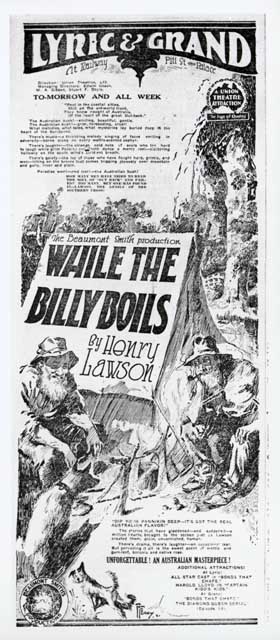
While the Billy Boils is a 1921 Australian film from director Beaumont Smith which adapts several stories from Henry Lawson. It is considered a lost film.
"The Drover's Wife" is a dramatic short story by the Australian writer Henry Lawson. It recounts the story of a woman left alone with her four children in an isolated hut in the outback in the late 19th century.

In the Days When the World Was Wide and Other Verses (1896) is the first collection of poems by Australian poet and author Henry Lawson. It was released in hardback by Angus and Robertson in 1896, and features the poet's widely anthologised poems "The Free Selector's Daughter", "Andy's Gone with Cattle", "Middleton's Rouseabout" and the best of Lawson's contributions to The Bulletin Debate, a famous dispute in The Bulletin magazine from 1892-93 between Lawson and Banjo Paterson.
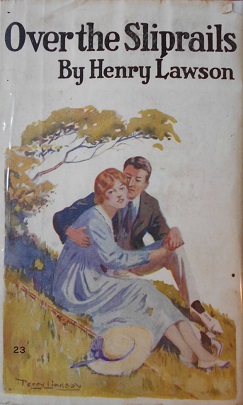
Over the Sliprails (1900) is a collection of short stories by Australian poet and author Henry Lawson. It was released in hardback by Angus and Robertson in 1900, and features some of the author's lesser known stories.

On the Track (1900) is a collection of short stories by Australian poet and author Henry Lawson. It was released in hardback by Angus and Robertson in 1900, and features one of the author's better known stories in "Bill, the Ventriloquial Rooster", as well as a number of lesser known works.

While the Billy Boils is a collection of short stories by the Australian writer Henry Lawson, published by Angus and Robertson in 1896. It includes "The Drover's Wife", "On the Edge of a Plain", and "The Union Buries Its Dead".
"His Father's Mate" is a melodramatic short story by Henry Lawson. It was first published in the 22 December 1888 issue of The Bulletin, and later included in the author's short story collection, While the Billy Boils, and in many short story anthologies. It was the author's first published short story.